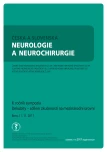Wound Healing – Cost-effectiveness Data from the Providers and Payers Viewpoint
Authors:
J. Stryja 1,2; J. Turoň 2
Authors‘ workplace:
Vzdělávací a výzkumný institut AGEL
Salvatella s. r. o., Třinec
1; Česká průmyslová zdravotní pojišťovna, pobočka Třinec
2
Published in:
Cesk Slov Neurol N 2017; 80(Supplementum 1): 18-20
Category:
Original Paper
doi:
https://doi.org/10.14735/amcsnn2017S18
Overview
Background:
Health insurance companies dispose cost-effectiveness data of the policyholders. We decided to ask a question: Is it possible to utilize these information for the cost-effectiveness analysis and quality-of-care evaluation?
Methods:
we have studied a group of the Czech Industrial Health Insurance Company policyholders treated with a non-healing wound during a period of three years (2014 – 2016). Policyholders treated with listed specific disorders (venous leg ulcer, pressure ulcers grade II, III and IV, ischemic wounds with gangrene due to peripheral artery occlusive disease, surgical site infections and cellulitis) have been included into the retrospective study.
Results:
The average duration of the moist dressing treatment varied from 1,1 (cellulitis) to 5,5 (ischemic wound with gangrene) months. The average yearlong costs of treatment per patient amounted to 9,329 CZK (venous leg ulcer patients), 7,055 CZK (patients with pressure ulcers grade II), 14,508 CZK (patients with pressure ulcers grade III) and 22,528 CZK (patients with pressure ulcers grade IV). Average yearlong costs per patient of ischemic wound treatment reached to 41,454 CZK and surgical sine infections to 6,754 CZK. The costs of moist dressings have comprised 14% of the total costs.
Conclusion:
Moist dressing costs are only a small fraction of total costs of treatment. Complex causal approach to the non-healing wound management, efficient local therapy and respecting of regimen precautions can improve the results of our effort and is cost-effective.
Key words:
costs – moisture wound healing materials – leg ulcer – pressure ulcer – gangrena – wound infection
The authors declare they have no potential conflicts of interest concerning drugs, products, or services used in the study.
The Editorial Board declares that the manuscript met the ICMJE “uniform requirements” for biomedical papers.
Sources
1. Stryja J, et al. Repetitorium hojení ran II. Semily: GEUM 2016.
2. Zdravotnické prostředky. Všeobecná zdravotní pojišťovna České republiky. [online]. Dostupné z URL: https:/ / www.vzp.cz/ poskytovatele/ ciselniky/ zdravotnicke-prostredky.
3. Franks P, Barker J, Collier M, et al. Management of patients with venous leg ulcer; challenges and current best practice. J Wound Care;25(Suppl 6):S1 – 67. doi: 10.12968/ jowc.2016.25.Sup6.S1.
4. Glove D, et al. Best practice for the Management of Lymphoedema – 2nd edition. Compression Therapy: a position document on compression bandaging. The International Lymphoedema Framework in association with the World Alliance for Wound and Lymphoedema Care. London: MEP 2012.
5. Pokorná A, Benešová K, Jarkovský J, et al. PressureInjuries in Inpatient Care Facilities in the Czech Republic: Analysis of a National Electronic Database. J Wound Continence Nurs 2017;44(4):331 – 5. doi: 10.1097/ WON.0000 000000000344.
6. Pokorná A, Benešová K, Mužík J, et al. Sledování dekubitálnich lézí u pacientu s neurologickým onemocněním – analýza Národního registru hospitalizovaných. Cesk Slov Neurol N 2016;79/ 112(Suppl 1):S8 – 14. doi: 10.14735/ amcsnn2016S8.
Labels
Paediatric neurology Neurosurgery NeurologyArticle was published in
Czech and Slovak Neurology and Neurosurgery

2017 Issue Supplementum 1
- Advances in the Treatment of Myasthenia Gravis on the Horizon
- Memantine Eases Daily Life for Patients and Caregivers
- Metamizole vs. Tramadol in Postoperative Analgesia
Most read in this issue
- Validaton of Nursing Diagnosis of Acute and Chronic Pain According to NANDA International in the Patients with Wound
- Employment of Flap Surgery in Pressure Ulcers Surgical Treatment
- Differential Diagnosis in Pressure Ulcers and Medical Devices
- Pressure Ulcers Represents a Constant Nightmare for Me
